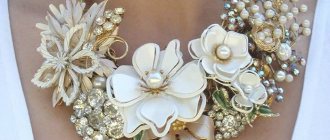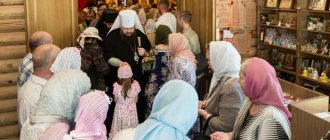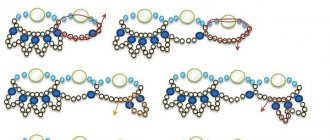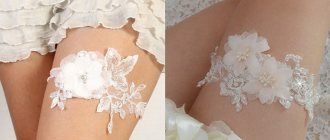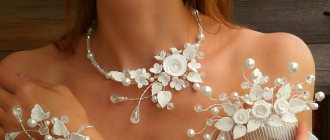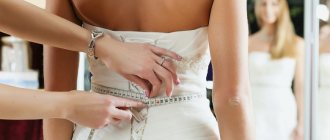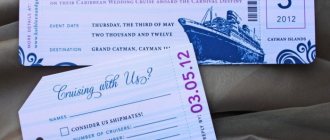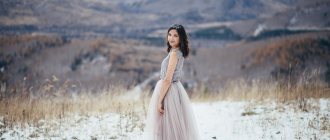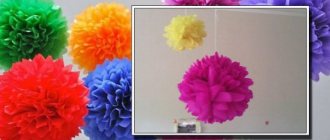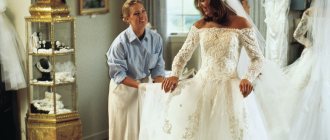A wedding is one of the most important events in the life of every woman! Brides are anxiously awaiting the wonderful opportunity to feel like a real queen and show off their beautiful outfit to the guests. The fashion for wedding clothes is changing so rapidly that brides are increasingly resorting to custom tailoring of dresses. How to sew it yourself? In this article we will tell you how to construct a pattern, how to sew a wedding dress, and also how to make your outfit unique and unusual;)
Sewing a wedding dress
Important points
Before you start sewing the product, you will need to prepare properly.
First, you need to determine the time you will need to make the product. Please note that searching for or independently creating patterns for wedding dresses will take you more than one day. Even with some experience in sewing, we recommend starting the process no later than a month before the celebration.
Secondly, prepare the tools and materials that should always be at hand: sharpened scissors, matching threads, pins, a set of needles, a fabric marker, lining, decorative elements of the dress, a sewing machine.
Thirdly, decide on the style. We recommend starting your search for patterns with fashion magazines or clothing catalogs. Remember that by choosing the right fabric and accessories, almost any outfit can be turned into a festive one! Give preference not to the most fashionable, but to the dresses that best suit your figure, because you should be comfortable in it.
Fourth, be sure to take individual measurements. The tape should run freely, but not sag or tighten the skin!
You can find out how the chosen dress will fit your figure using special programs that you can easily find on the Internet. As an alternative (and it’s more reliable, however!), we recommend contacting a specialized salon. There, with the help of professionals, you will select the style, fabric, accessories and make the final choice.
Selection of fabric for a dress
Today, any more or less large fabric store offers hundreds of fabric options, however, when your goal is to sew a wedding dress, try to soberly weigh your capabilities and skills. As a rule, dresses are made from silk, tulle, cotton, taffeta or satin.
If you have very little experience in sewing, give preference to simple fabrics - silk, chiffon, lace (especially elastic!) may be too much for even craftswomen who previously had no problems sewing women's outfits.
The fabric of the dress is selected in accordance with the theme of the celebration.
Silk outfit for a wedding in an aristocratic style:
A lace dress is suitable for sophisticated and sophisticated young ladies:
A chiffon outfit is ideal for an outdoor ceremony:
Taffeta is perfect for a winter wedding:
When choosing a fabric, its color also plays an important role. Most often, brides prefer classic white or milky colors, however, if you want to stand out, why not? The color or its shade should, first of all, please you and match your skin tone. Pay attention to pink, beige, blue or bright scarlet. You can either sew an entire outfit from this fabric or use it to make bright accents.
Selection of accessories
You can purchase accessories at a showroom or fabric store. Give preference to high-quality accessories that will not only withstand the sewing process, but will also look decent for a long time.
In recent years, colored lacing has been extremely popular:
Embroidering the corset of a dress with Swarovski crystals is always relevant:
A bow is always a good idea:
The outfit can also be decorated with flowers:
In addition, you can decorate your outfit with rhinestones, pearls, brooches, embroidery, ribbons, bows... Experiment with lacing, beads, beads, appliqués and even chains! And, of course, don’t forget about the lace!
Beaded Dress:
Outfit with brooch:
With embroidery:
And here’s what a wedding dress with lace looks like:
It is very important that the selected decorative elements look good together. For example, ribbons go well with pearls, but if you dare to add rhinestones or beads to them, the dress will look tasteless, as it is “overloaded” with jewelry.
Selection of style
There are so many variations of wedding dresses that your head is spinning! Below we will offer you the most popular, and, in our opinion, universal styles of dresses for brides.
Straight wedding dress in Greek style with a train:
Mermaid model:
Lush wedding dress (can be either floor-length or just below the knee):
With guipure insert:
One Shoulder Halter Outfit:
Short wedding dress:
Outfits with a deep slit on the back look very elegant:
No less attractive are the outfits for brides with a closed neckline:
Empire dresses also do not lose their leading positions in the world of wedding fashion:
Ten stylish tips for choosing a wedding dress style
The choice of style directly depends on the proportions (height and figure). Below we give a few tips that should not be neglected if you want to sew a wedding dress with your own hands.
- For girls of small stature, a modest, floor-length outfit is best suited. In combination with a high heel, it elongates the figure.
- It is better for plus-size women to avoid outfits with voluminous skirts; in such a situation, a straight dress would be optimal.
- For ladies with curvy hips, we advise you to take a closer look at dresses with a round neckline, open shoulders and a lace top - this way you will shift the emphasis from the hips to the chest and neck.
- Tall height will be hidden (if, of course, you want to hide it) by a dress with a full skirt.
- Lush breasts look neater in a dress with a high neckline. It would also suit a lady with a swan neck;)
- Grecian-style wedding dresses and bustier dresses look great on figures with a small bust.
- For the lucky owners of an hourglass figure, any model will suit you, but we recommend paying attention to the “mermaid” or “fish” - your waist in such an outfit will be even thinner!
- Apple-shaped figures will also suit an outfit with a high waistline.
- If you can boast of slender legs, pay attention to short wedding dresses.
- For girls with a beautiful shoulder line, we recommend thinking about a dress with straps that are slightly lowered on the forearms.
Constructing a pattern
Has your wedding dress pattern been chosen? Then you can safely transfer it to tracing paper using carbon paper and cut out the pattern in full size.
If your search for a pattern to sew a wedding dress has not been successful, you can try to build it yourself using individual measurements. The finished pattern can be found in magazines (we recommend checking out Burda issues), purchased in fabric stores or found on the Internet.
Important! Be sure to check the purchased or downloaded pattern with your measurements and, if necessary, adjust it!
Work on a drawing, as a rule, begins with the construction of a basic mesh. Having completed the appropriate calculations, we draw the points, connect them with segments, form the neckline, darts, waistline, shoulder bevel and adjust the length of the product. Sewing a wedding dress with your own hands using your own pattern will be within the capabilities of experienced craftswomen, but we recommend that beginners use ready-made patterns.
What to wear with?
As with any other wedding dress, you need to choose the right accessories for a knitted dress.
Veil
This most popular wedding accessory will decorate any bride. For a knitted dress, it is recommended to choose a classic veil made of tulle or other light fabric. A lace model in this case will make the image heavier.
When choosing a veil model, you should consider the style of the dress. Models with full skirts look good when paired with a multi-layered full veil. It is better to complement a straight or figure-fitting dress with a light veil without additional decor.
The length of the veil may vary. As a rule, a long veil is worn with a long dress and vice versa. But there are exceptions to this rule. For example, if a dress has a spectacular cutout on the back, then you should not cover it with a veil
Shoes
It is best to wear classic shoes with a crocheted lace wedding dress without additional decor. Most styles require heels. However, if the bride chose an empire style outfit or decided to wear a knitted sundress in a rustic style, then stiletto heeled pumps would be inappropriate. These outfits require shoes with a round toe and a small square heel or ballet flats. Sandals go great with a beach style dress.
Gloves
You can wear gloves with a sleeveless dress. If the dress is completely lace, then it is better to choose gloves with a smooth texture - made of satin or taffeta. But for a combined dress, in which individual elements are made of crocheted lace, openwork gloves that repeat the lace pattern on the dress are perfect.
Decorations
If the bride chose a knitted wedding dress, then jewelry will need to be used in minimal quantities. The shine of metal and stones should not overshadow the delicate beauty of crocheted lace.
For a model with a neckline, you can wear a thin chain with a small pendant or an elegant necklace. But if the bodice is decorated with rhinestones and sequins, then it is better not to wear anything on the neck, limiting yourself to long earrings.
We sew a train for a wedding dress
The train automatically makes any floor-length robe look elegant! It is suitable for both a lush wedding dress and a Greek-style outfit. The train can be of any length and shape, but a train that is too heavy can prevent the bride from moving and dancing freely. To sew a dress with a train, you should focus on the overall style and texture of the outfit.
There are several ways to cut a train. If desired, you can always add stride length by sewing in an additional wedge. It should be sewn into the back of the skirt, making this wedge longer than the dress itself.
Another option is to lengthen the main seam of the back side of the dress to the required length. The side seams should also be widened. When cutting, you need to leave small seam allowances (about one centimeter).
Educational videos for fashionistas and needlewomen
On YouTube, beginning needlewomen can find a huge number of video tutorials that show in detail the entire process of sewing things. For example, a series of lessons from the master Olga Nikishicheva fell in love with the viewers of Channel One, and we can watch them and get inspired. And there are a lot of such good masters, so feel free to choose the one you like.
Simple long dress for plus size ladies at home
For a woman with curvaceous figures, floor-length dresses should be tailored individually to her figure, because such a chic lady should be decorated with no less chic outfits.
Ladies often prefer the bat model, but stylists advise choosing “tulip”, “case” or “pencil”.
https://www.youtube.com/watch?v=QVlQj0yWGZs&list=PLSglabjZeV0V3jce8tp0550tOnhdfPZSz
Beautiful jersey with three-quarter sleeves
A knitted garment is very easy to sew, as it does not require undercuts. With a cowl collar and fringe, you can create a boho-style outfit.
For pregnant women with high waist
Expectant mothers have a lot of free time during pregnancy, which allows them to create, create, create.
Sewing pattern for a wedding dress
Having decided on the fabrics, style, decor and selected a pattern, we can proceed directly to sewing the product. Below we provide a description for a model with a bodice and a fluffy skirt.
Stage one
We are making a pattern. We transfer all measurements onto paper. Having cut out the patterns, we apply them to the fabric and trace them twice: the first time clearly along the contour, the second with an indent of one or two centimeters, and at the bottom of the dress and at the junction of the skirt with the corset - four to five centimeters (seam allowances).
During the sewing process, be sure to try on individual blanks and elements fastened with pins. We outline the parts and try the workpiece on the model. During fitting, carefully inspect the workpiece from all sides and correct possible shortcomings and flaws in the cut.
Having adjusted the cuts and folds of the fabric, we form the final hem of the skirt. Gather the fabric at the waist. Six wedges should form, sew them together in the waist area. As a result, we will have a remarkably shape-retaining base.
Stage two
We sew “bones” (metal or plastic thin flat inserts) into the lining to form a rigid frame. Thus, we shape the bodice of the dress for the wedding. We sew all the blanks together using a sewing machine.
We sew translucent chiffon on top of the frame in several layers. The top part will eventually be zipped up.
We attach the bodice to the bottom of the future outfit.
The skirt is sewn quite simply - first we drape it from several layers of chiffon of the previously selected color. Next, we sew the layers together to get a fluffy and voluminous skirt. Afterwards we sew it to the bodice.
That's it, the wedding dress is ready!! It can always be decorated with flowers, a large bow, elegant gold embroidery, pearls or rhinestones.
You can choose accessories for the dress that match the season and theme of the wedding. The following are always in fashion:
- a fur cape (a short one looks good on sizes from XS to L, for plus-size women we recommend taking a short fur coat);
- clutch bag;
- hat (a good studio sews such an accessory quickly and relatively inexpensively);
- veil (from flirty short to long and even with a train);
- gloves (short or above the elbow);
- light veil.
Experiment with jewelry: a bright bracelet, brooch, ring or earrings will become a bright accent of your look!
